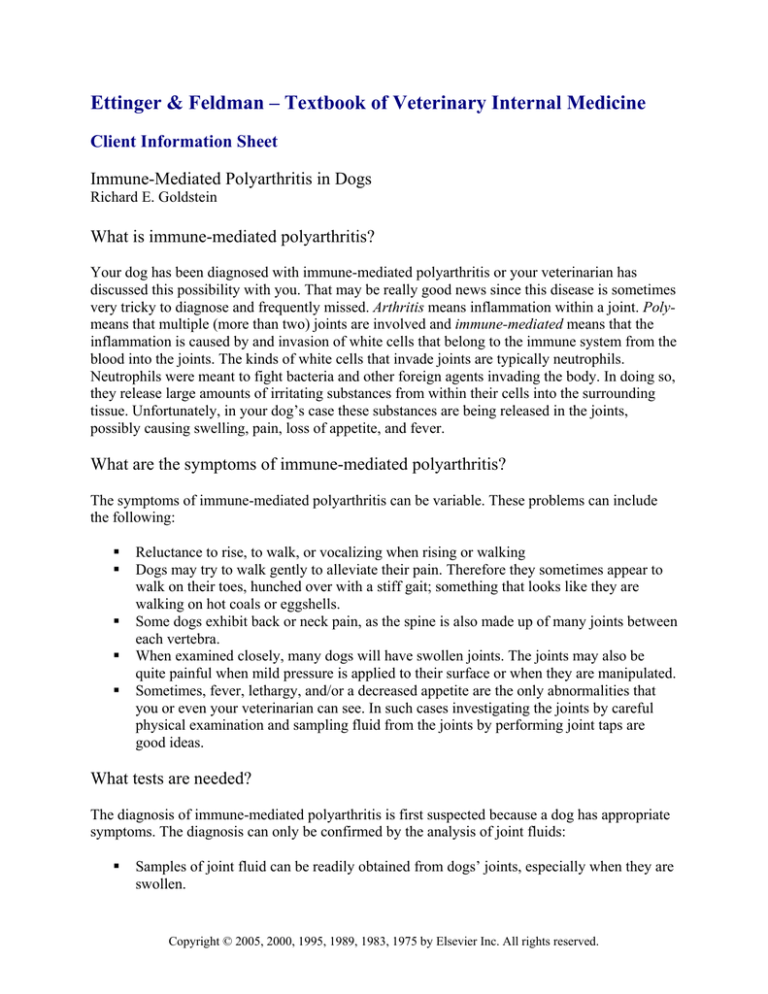
Ettinger & Feldman – Textbook of Veterinary Internal Medicine
Client Information Sheet
Immune-Mediated Polyarthritis in Dogs
Richard E. Goldstein
What is immune-mediated polyarthritis?
Your dog has been diagnosed with immune-mediated polyarthritis or your veterinarian has
discussed this possibility with you. That may be really good news since this disease is sometimes
very tricky to diagnose and frequently missed. Arthritis means inflammation within a joint. Polymeans that multiple (more than two) joints are involved and immune-mediated means that the
inflammation is caused by and invasion of white cells that belong to the immune system from the
blood into the joints. The kinds of white cells that invade joints are typically neutrophils.
Neutrophils were meant to fight bacteria and other foreign agents invading the body. In doing so,
they release large amounts of irritating substances from within their cells into the surrounding
tissue. Unfortunately, in your dog’s case these substances are being released in the joints,
possibly causing swelling, pain, loss of appetite, and fever.
What are the symptoms of immune-mediated polyarthritis?
The symptoms of immune-mediated polyarthritis can be variable. These problems can include
the following:
Reluctance to rise, to walk, or vocalizing when rising or walking
Dogs may try to walk gently to alleviate their pain. Therefore they sometimes appear to
walk on their toes, hunched over with a stiff gait; something that looks like they are
walking on hot coals or eggshells.
Some dogs exhibit back or neck pain, as the spine is also made up of many joints between
each vertebra.
When examined closely, many dogs will have swollen joints. The joints may also be
quite painful when mild pressure is applied to their surface or when they are manipulated.
Sometimes, fever, lethargy, and/or a decreased appetite are the only abnormalities that
you or even your veterinarian can see. In such cases investigating the joints by careful
physical examination and sampling fluid from the joints by performing joint taps are
good ideas.
What tests are needed?
The diagnosis of immune-mediated polyarthritis is first suspected because a dog has appropriate
symptoms. The diagnosis can only be confirmed by the analysis of joint fluids:
Samples of joint fluid can be readily obtained from dogs’ joints, especially when they are
swollen.
Copyright © 2005, 2000, 1995, 1989, 1983, 1975 by Elsevier Inc. All rights reserved.
Immune-Mediated Polyarthritis in Dogs
Page 2
This process (“joint taps”) involves placing a small needle attached to a syringe into the
joint space, removing a few drops of fluid, and evaluating the contents under a
microscope.
If indicated, your veterinarian may send a fluid sample to a laboratory for evaluation and
possibly for a bacterial culture as well.
Although joint taps may be associated with some discomfort, the procedure is usually
quick and almost never requires anesthesia.
Immune-mediated polyarthritis is usually an acute (rapidly developing) process, and is very
different from what is commonly called “arthritis” or degenerative joint disease. The latter is a
slow degenerative process that is associated with damage to the cartilage in the joints. It, too, is
associated with pain but typically not with the same degree of pain and not with marked joint
swelling, fever and a poor appetite.
Another type of arthritis is septic arthritis. This is caused by a primary bacterial infection within
the joint itself. Septic arthritis usually affects one joint but can affect more than one. Sometimes
differentiating between septic arthritis and immune-mediated arthritis is difficult. In both cases
analysis of joint fluid will show large amounts of neutrophils. If bacteria are seen in the joint
fluid analysis under a microscope or if bacteria are grown in a culture then the diagnosis of septic
arthritis is substantiated. That may take quite a few days and frequently, even if there are bacteria
seen, they do not grow in the culture. In some cases your veterinarian will not be able to be sure
and might have to treat for immune-mediated as well as septic arthritis. Another hint that can be
used is that septic arthritis usually affects the larger joints (knees, hips, elbows), whereas
immune-mediated arthritis usually affects the smaller joints like carpi (wrists) and hocks
(ankles).
What causes immune-mediated polyarthritis?
Why did your dog get immune-mediated polyarthritis? Why is your dog’s immune system
attacking his or her own joints? Two broad possibilities follow:
1. Secondary/systemic disease
2. Primary/idiopathic disease
Your dog’s immune system problems may be secondary to an additional systemic disease. This
other disease has caused the immune system to overreact and to lose some of its regulation or
self-control, so instead of just fighting the primary disease it also starts attacking your dog’s own
tissues. Diseases that can cause this phenomenon are those that cause a strong reaction of the
immune system such as infectious diseases and cancer. Infectious disease can include specific
types of bacteria that are carried by ticks and frequently cause immune-mediated joint disease
like ehrlichia or lyme disease, or any chronic (long lasting) bacterial, viral, or fungal infection.
Cancer elsewhere in the body can also arouse the immune system in a way that causes it to
overreact and attack the joints. Therefore after diagnosing immune-mediated joint disease in
your dog your veterinarian may ask to perform additional diagnostic testing including blood and
urine testing and possibly x-rays and/or ultrasound to try and find an “underlying” disease.
Copyright © 2005, 2000, 1995, 1989, 1983, 1975 by Elsevier Inc. All rights reserved.
Immune-Mediated Polyarthritis in Dogs
Page 3
Treating the immune disease will be much more efficient if such an underlying disease can be
found and treated. This type of secondary immune-mediated disease can happen in body systems
other than the joints. Such abnormalities may include destruction of your dog’s red cells (cells
that carry oxygen in the blood) or platelets (cells active in the clotting process). These could
result in an anemia or possibly a bleeding disorder. Other common organs attacked by the
immune system are skin and kidneys. Once your veterinarian diagnoses immune-mediated
disease in one other organ, it may be wise to look for evidence of disease in other organs as well.
If no underlying disease is found, your dog may have “primary” or “idiopathic” immunemediated polyarthritis. In this case the immune system has attacked the joints for no apparent
reason. Just like with secondary immune-mediated polyarthritis, the same process may be going
on in the other body systems as well.
What treatment is needed?
When recommending a treatment plan for your dog, your veterinarian will take into account the
possibility of underlying infectious or cancerous disease. If such a disease is identified and can
be treated, the joint disease may resolve as the underlying disease resolves. Unfortunately, this is
usually not the case. Many times your veterinarian will send off blood tests looking for infectious
causes of polyarthritis and then have to wait weeks for the result. In the mean time it is usually
safe to start antibiotic therapy in the event that bacteria are involved. Doxycycline is an
antibiotic commonly used for this purpose since it works well against many bacteria that can
cause polyarthritis. Other antibiotics can be used as well.
When the chances of an infectious cause for your dog’s polyarthritis are ruled out or deemed
unlikely then treatment for primary or idiopathic immune-mediated polyarthritis may be
prescribed. The goal of treatment in this setting is immunosuppression, or shutting down the
immune system. Prednisone (a steroid) is the most common medication used for this purpose.
There is a good chance that your dog will feel much better within a few days of steroid therapy.
But remember, this treatment will likely have to be given for months! Stopping too early may
make symptoms return. Your veterinarian may prescribe a high dose of prednisone initially and
then slowly taper the dose.
Side effects of steroids are common and they include the following:
Increased drinking
Increased urination
Increased appetite
Panting
Weakness
Rarely, more severe side effects such as blood clots, liver disease, or diabetes
Some veterinarians will treat with an additional immunosuppressive drug like azathioprine along
with the prednisone. Your veterinarian will have to recheck your dog every few weeks and likely
Copyright © 2005, 2000, 1995, 1989, 1983, 1975 by Elsevier Inc. All rights reserved.
Immune-Mediated Polyarthritis in Dogs
Page 4
repeat the joint taps as the medications are tapered. Don’t rush! Better to be patient than to have
a recurrence of the disease.
Prognosis
Most cases of immune-mediated polyarthritis are treatable and with a combination of a thorough
search and aggressive treatments of underlying diseases, long-term immunosuppressive therapy,
frequent follow-up visits, and some luck, your dog has a good chance to eventually make a full
recovery.
Contacts for Further Information
Copyright © 2005, 2000, 1995, 1989, 1983, 1975 by Elsevier Inc. All rights reserved.




